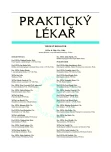Evoluce a evoluční teorie pro lékaře
V. Darwinovy teorie evoluce
Authors:
F. Koukolík
Authors‘ workplace:
Oddělení patologie a molekulární medicíny
; Národní referenční laboratoř prionových chorob
; Fakultní Thomayerova nemocnice s poliklinikou, Praha
Published in:
Prakt. Lék. 2010; 90(5): 268-273
Category:
Editorial
Overview
“Darwin’s theory” is an inaccurate term. In reality there are five basic Darwinian theories of evolution. In addition to rejecting biblical literalism Darwin’s theories impeded and impede essentialism and finalism. Essentialism is a basis of transmutationism and transformationism, both antiquated theories. Darwin replaced essentialism by population thinking. So-called Modern synthesis (neo-Darwinism) evolved in the first half of the last century. Contemporary evolutionary genomics corroborates three of the six pillars of Modern synthesis:
- random heritable variations,
- uniformitarianism and
- the last universal common ancestor,
but refutes the next three pillars:
natural selection as the main driving force of evolution,
gradualism (evolution in „infinitesimally“ small steps), and
a single large Tree of life.
Key words:
Darwin’s five theories, six theoretical pillars of Modern synthesis (neodarwinism), contemporary evolutionary genomics.
Sources
1. Clintock, B. The origin and behavior of mutable loci in maize. Proc. Natl. Acad. Sci. USA 1950, 36, p. 344-355.
2. Dawkins, R. The selfish gene. Oxford: Oxford University Press, 1976.
3. Dehal, P, Boore, J.L. Two rounds of whole genome duplication in the ancestral genome. PLoS Biol. 2005, 3: e314.
4. Doolitle, W.F., Sapienza, C. Selfish genes , the phenotype paradigm and genome evolution. Nature 1980, 284, p. 601-603.
5. Doolitle, W.F., Baptiste, E. Pattern pluralism and the Tree of Life hypothesis. Proc. Natl. Acad. Sci. USA 2007, 104, p. 2043-2049.
6. Drummond, D.A., Bloom, J.D., Adami, C. et al. Why highly expressed proteins evolved slowly. Proc. Natl. Acad. Sci. USA 2005, 102, p. 14338-14343.
7. Eisen, J.A., Fraser CM. Phylogenomics: intersection of evolution and genomics. Science 2003, 300, p. 1706-1707.
8. Embley, T.M., Martin, W. Eukaryotic evolution, changes and challenges. Nature 2006, 440, p. 623-630.
9. Fedorov, A., Merican, A.F., Gilbert, W. Large-scale comparison of intron positions among animal plant and fungl genes. Proc. Natl. Acad. Sci. USA 2002, 99, p.16128-16133.
10. Gogarten, J.P., Townsend, J.P. Horizontal gene transfer, genome inovation and evolution. Nat. Rev. Microbiol. 2005, 3, p. 679-687.
11. Goodier, J.L., Kazazian, H.H. Jr. Retrotransposons revisited. The restraint and rehabilitation of parasites. Cell 2008, 135, p. 23-35.
12. Gould, S.J., Lewontin, R.C. The spandrels of San Marco and the Panglossian paradigm: a critique of the adaptationist programme. Proc. R. Soc. Lond. B. Biol. Sci. 1979, 205, p. 581-598.
13. Gould, S.J. The exaptive excellence of spandrels as a term and prototype. Proc. Natl. Acad. Sci. USA 1997, 94, p.10750-10755
14. Gray, M.W., Burger, C., Lang, B.F. The origin and early evolution of mitochondria. Genome Biol. 2001, 2(6), reviews1018.1–1018.5.
15. Hoegg, S. Meyer, A. Hox clusters as models for vertebrate genome evolution. Trends Genet. 2005, 201, p. 421-424.
16. Jaillon, O., Bouhouche, K., Gout J,F. et al. Translational control of intron splicing in eucaryotes. Nature 2008, 451, p. 359-362.
17. Kimura, M. Evolutionary rate at the molecular level. Nature 1968, 217, p. 624-626.
18. King, J.L., Jukes, T.H. Non-darwinian evolution. Science 1969, 164, p. 788-798.
19. Koonin, E.V., Senkevich, T.G., Dolja, V.V. The ancient virus world and the evolution of cells. Biol. Direct. 2006, 1, p. 29.
20. Koonin, E.V., Wolf, Y.I. In: Pagel M., Pomiankowski A (eds.). Evolutionary genomic and proteomics. Sunderland MA: Sinauer Ass. Inc., 2008 A, p. 11-25.
21. Koonin, E.V., Wolf, Y.I. Genomics of bacteria and archaea: the emerging generalizations after 13 years. Nucleic. Acid. Res. 2008, 36, p. 6688-6719.
22. Koonin, E.V. Darwinian evolution in the light of genomics. Nucleic. Acid. Research 2009, 37, p. 1011-1034.
23. Koonin, E.V. Evolution of genome architecture. Int. J. Biochem. Cell Biol. 2009, 41, p. 298-306.
24. Liolios, K., Mavromatis, K., Tavernarakis, N. et al. The Genomes On Line Database (GOLD) in 2007: status of genomic and metagenomic projects and their associated metadata. Nucleic. Acid. Res. 2008, 36, D475-479.
25. Lynch, M., Katju, V. The altered evolutionary trajectories of gene duplicates. Trends Genet. 2004, 20, p. 544-549.
26. Lynch, M. The origin of genome architecture. Sunderland MA: Sinauer Associates, 2007.
27. Martin, W., Hoffmeister, M., Rotte, C. et al. An overview of endosymbiotic models for the origin of eukaryotes, their ATP-producing organelles (mitochondria and hydrogenosomes) and their heterotrophic lifestyle. Biol. Chem. 2001, 382, p. 1521-1539.
28. Mayr, E. What evolution is. New York: Basic Books, 2001.
29. Mushegian, A. Gene content of LUCA, the last universal common ancestor. Front. Biosci. 2008, 13, p. 4657-4666.
30. Obbard, D.J., Gordon, K.H.J., Buck, A.H. et al. The evolution of RNAi as a defense against viruses and transposable elements. Phil. Trans. R. Soc. B 2008, 364(1513), p. 99-115.
31. Ohno, S. Evolution by gene duplication. Berlin-Heidelberg-New York: Springer-Verlag, 1970.
32. Orgel, L.E., Crick, F.H. Selfish DNA: the ultimate parasite. Nature 1980, 284, p. 604-607.
33. Park, J.W., Graveley, B.R. Complex alternative splicing Exp. Med. Biol. 2007, 623, p. 50-63.
34. Sagan, L. The origin of mitosing cells. J. Theor. Biol. 1967, 14, p. 255-274.
35. Tax, S., Callender, C. (Eds.) Evolution after Darwin; the University of Chicago Centennial. Chicago: University of Chicago Press, 1960.
36. Venter, J.C., Remington, K., Heidelberg, J.F. et al. Environmental genome shotgun sequencing of the Sargasso sea. Science 2004, 304, p. 66-74.
37. Woese, C.R. Bacterial evolution. Microbiol. Rev. 1987, 51, p. 221-271.
38. Yosef, N., Kupiec, M., Ruppin, E. et al. A complex-centric view of protein network evolution. Nucleic. Acid. Res. 2009, 37(12), e88.
Labels
General practitioner for children and adolescents General practitioner for adultsArticle was published in
General Practitioner

2010 Issue 5
Most read in this issue
- Food-borne infections and intoxications
- Does bisexuality exist?
- Effective hemostasis in bloodless surgery-review
- Assessment of surrogate family care applicants’ health status
